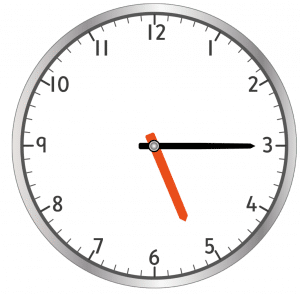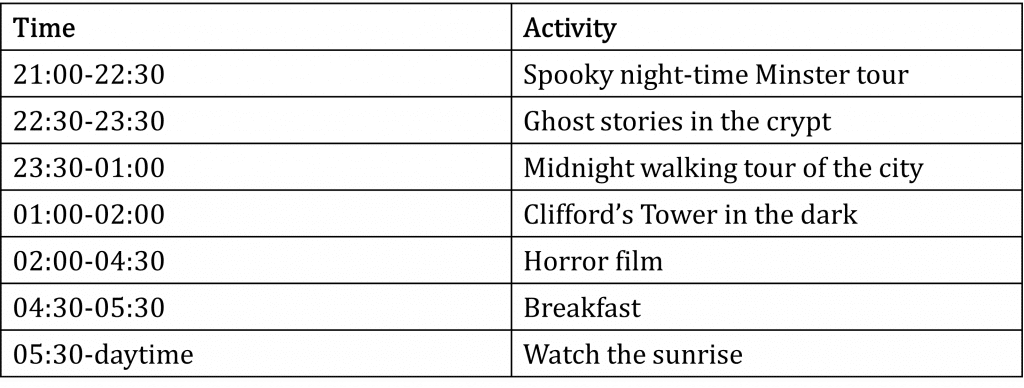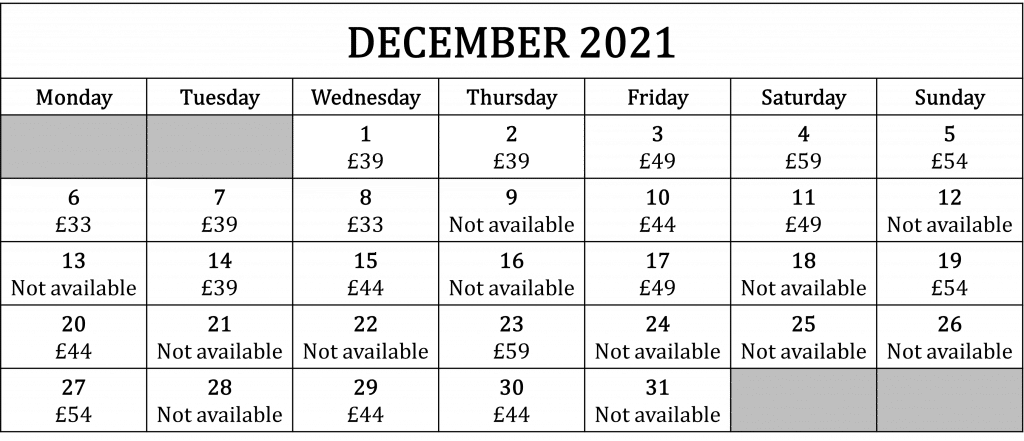Functional Skills: Time
Time
Time is a measurement used in everyday life.
Units of Time
As you may know, time has a variety of different units. You will need to be able to change between them.
Here is a list of different units of time and how they are related:
- 60 seconds =1 minute
- 60 minutes =1 hour
- We can divide 1 hour like this:
- 15 minutes =\frac{1}{4} hour
- 30 minutes =\frac{1}{2} hour
- 45 minutes =\frac{3}{4} hour
- 24 hours =1 day
- 7 days =1 week
- 365 days =1 year
- 12 months =1 year
- 10 years =1 decade
- 100 years =1 century
\boldsymbol{12}-hour clock vs \boldsymbol{24}-hour clock


The time of day can be given using a \textcolor{purple}{12}-hour clock or a \textcolor{green}{24}-hour clock.
The \textcolor{purple}{12}-hour clock goes from 12.00am to 11.59am and then 12.00pm to 11.59pm.
For example, 8 am is 8 o’clock in the morning and 8pm is 8 o’clock in the evening.
The \textcolor{green}{24}-hour clock goes from 00:00 to 23:59
For example, 06:30 is half past 6 in the morning, and 18:30 is half past 6 in the evening.
To go between afternoon times from the \textcolor{purple}{12}-hour clock to the \textcolor{green}{24}-hour clock, you need to add \textcolor{orange}{12} hours. To go the other way, you subtract \textcolor{orange}{12} hours from the \textcolor{green}{24}-hour clock.
Follow Our Socials
Our Facebook page can put you in touch with other students of your course for revision and community support. Alternatively, you can find us on Instagram or TikTok where we're always sharing revision tips for all our courses.
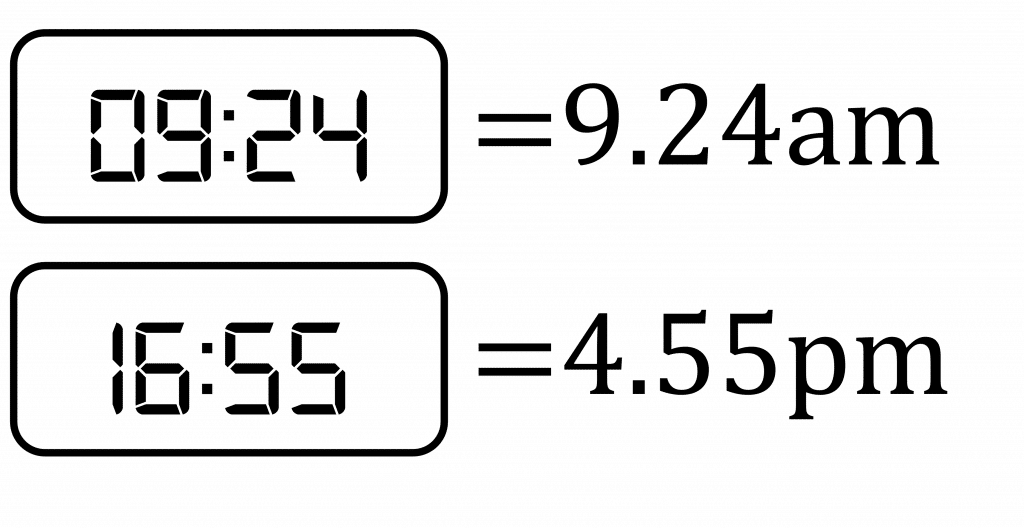

Digital Clocks
Reading time on a digital clock is simple: the first two digits show the hour, then a colon separates the hours and minutes, then the second two digits show the minutes.
Digital clocks use 24 hour time, so it is important to know how to interpret that to read a digital clock.
Analogue Clocks
On an analogue clock, the small hand points to the hour while the big hand points to the minute. However, it is not as simple as reading off times in either case.
1. For the big hand, because there are only 12 numbers on an analogue clock, each number represents 5 minutes, not 1 minute. So when the big hand points to 4, it is 20 minutes past the hour because 4\times5=20. If the minute hand is between numbers, this represents being between increments of 5 minutes.
Note: If the big hand points to 12, this does not mean it is 12\times5=60 minutes past, it means it is on the hour.
2. For the small hand, it will usually be between numbers. If it is between 10 and 11, then the hour is 10 and it gets closer to 11. Since there are only 12 numbers, the hour can only go up to 12, so analogue clocks are not 24 hour.
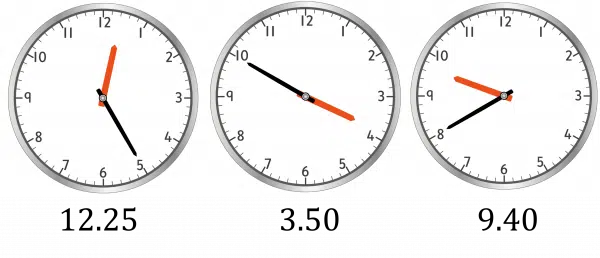
Working Out Times
The best way to work out times is to split it into chunks. This comes in two styles:
- Working out how long something takes.
- Working out what time it will be once something has happened.
Example: Jack sets off for work at 7.30am and arrives at 9.05am. How long does his journey take him?
Split this into chunks. First, to go from 7.30am to 8.00am is 30 minutes. Then to go from 8.00am to 9.00am is 1 hour. Then to go from 9.00am to 9.05am is 5 minutes.
Now, add the hours and the minutes separately.
We have 1 hour, and we have 30+5=35 minutes, so our total time is 1 hour 35 minutes.
Example: The train from Harrogate to York takes 45 minutes. If it leaves Harrogate at 18:40, what time does it arrive into York?
Again, split this into chunks. 18:40 to 19:00 is 20 minutes, so there are 45-20=25 minutes left.
25 minutes after 19:00 is 19:25, which is when the train gets into York.
Timetables
Timetables have rows and columns. Rows are horizontal and columns are vertical.
You need to know how to read several different types of timetables.
Bus timetables list in each column the times an individual bus gets to each stop. So to find the bus you need to get to arrive at a certain time you have to:
Step 1: Find the stop you want.
Step 2: Go along that row to find the last one before the certain time.
Step 3: Find the time that bus gets to the stop you want to get on at.
Example: Chloe wants to arrive at Clifton Moor by 10:30. She will get on the bus at Piccadilly. At what time does she need to be at Piccadilly bus stop?
Follow along the Clifton Moor row to find a time before 10:30 – in this case it is \textcolor{blue}{10:26}.
Now, follow this column up to Piccadilly – the stop Chloe is getting on at. This gives a time of 09:39, which is when the bus she needs to be on leaves Piccadilly.
Hence, she must be at the Piccadilly bus stop by \textcolor{blue}{09:39}.
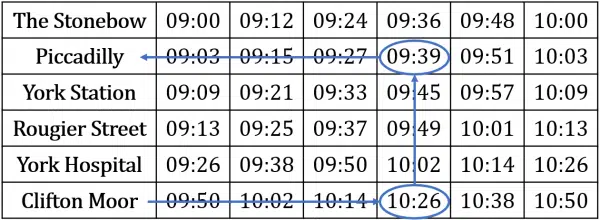
Some other types of timetable are much easier to read than bus timetables. To find out when an event takes place, simply look to the row and column headings for the row and column it is in.
Example: Fatima is going to an education conference. She is planning which sessions she wants to attend. She has a networking event running at the same time to the conference that is at 02.00pm on Saturday. Which session would she not be able to attend?
We need to look at the 02.00pm row and the Saturday column. Where these intersect is the event that Fatima will not be able to attend. This event is “Key Stage 2: Does the Curriculum Need and Overhaul?”

Calendars
Calendars show dates. Normally, each page of a calendar shows a grid that will represent a month. The days of the week will be listed along the top, then each square will have a number in which corresponds to that day of the month. Each square in a calendar can also contain information relating to that day. Questions on calendars are about being able to interpret this information.
Example: Jurgen has been in Germany since April and wishes to fly back to the United Kingdom in October. He will be flying from Berlin Brandenburg Airport into London Heathrow Airport. The calendar below shows the prices of flights from Brandenburg to Heathrow on each day. Jurgen wishes to fly between 11th and 15th October, and he wishes to spend the least money possible on flights. Which day should he choose?
The calendar shows us that no flights are available at all on 11th October and 14th October. This leaves Jurgen with 12th October, where flights cost £101, 13th October, where flights cost £89, and 15th October, where flights cost £130. The smallest cost out of these is £89 on 13th October. So Jurgen should travel on 13th October.
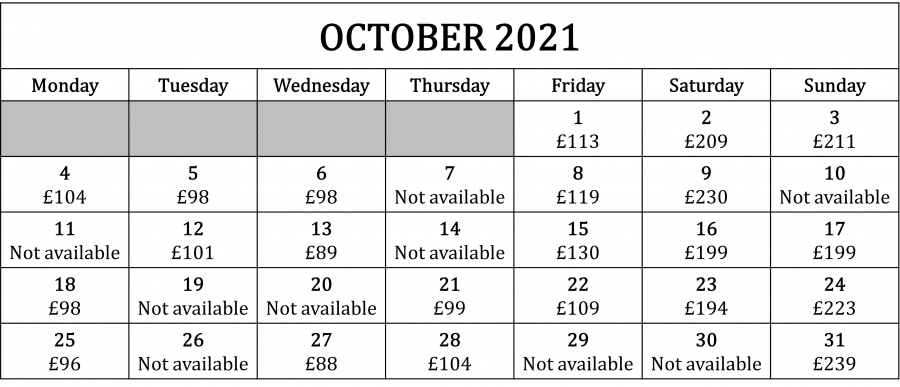
Functional Skills: Time Example Questions
Question 1: How many minutes is 360 seconds?
[1 mark]
There are 60 seconds in 1 minute.
360\div60=6 minutes
Question 2: Change the following times from the 12-hour clock to the 24-hour clock:
a) 4.35pm
b) 10.15pm
Change the following times from 24-hour clock to the 12-hour clock:
c) 18:45
d) 21:20
[4 marks]
a) and b) are both afternoon times, so add 12 hours to both:
a) 4.35pm =16:35
b) 10.15pm =22:15
c) and d) are also afternoon times, so subtract 12 hours from both:
c) 18:45=6.45pm
d) 21:20=9.20pm
Question 3: Georgia needs to catch the 13:49 bus to get to work on time. It takes her 18 minutes to walk to the bus stop from her house. If she sets off at 1.33pm, will she get to the bus stop on time?
[2 marks]
1.33pm is 13:33 using a 24-hour clock. If she sets off at 13:33, she will get to the bus stop at 13:51, so she won’t get to the bus stop on time.
Question 4: What times are being shown on these clocks? Give your answers in 12-hour format.
a)
b)
[2 marks]
a) 22:38=10.38pm
b) 5.15pm
Question 5: Tony has joined the overnight spooky tour of York to take place on Halloween night. He is given the following timetable for it.
a) Over what time does the midnight walk take place?
b) How long does the horror film last?
[2 marks]
a) 23:30-01:00
b) 2 hours 30 minutes
Question 6: Brainbender escape rooms prices vary by day based on demand. Ruth and Stephen are looking to book an escape room on a weekend in December, and they want to pay as little as possible. Which day should they choose?
[3 marks]
The available weekend days are Saturday 4th December, for £59, Sunday 5th December, for £54, Saturday 11th December, for £49, and Sunday 19th December, for £54.
The cheapest of these is Saturday 11th December, for £49, so they should choose this date.
Specification Points Covered
EL3.12 – Read, measure and record time using am and pm
EL3.13 – Read time from analogue and 24 hour digital clocks in hours and minutes
L1.20 – Convert between units of length, weight, capacity, money and time, in the same system









